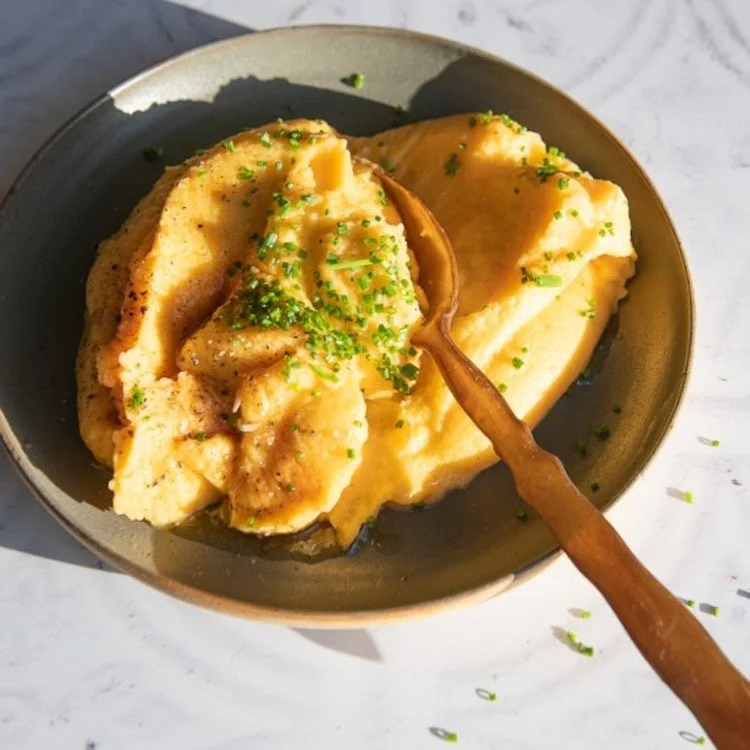Swede and beurre noisette velvet
Tweak up your Burns Supper with this quick and simple mash upgrade
Image by stillmotionarts
Beurre noisette (literally ‘hazelnut butter’, aka brown butter) is one of the classic preps in French cuisine. Simply butter cooked till it’s gloriously sweet and hazelnutty – in scent and taste – it transforms bashed neeps from rustic and hearty to sophisticated gourmet luxury. Velvet-smooth yet pleasingly dense in texture, the beurre noisette lends an almost fudgy, tablet-like sweetness, smoothing out the swede’s strong flavour and slightly bitter edges, characteristic of all crucifers (swede, cabbage, cauli, kale, broccoli, Brussels et al) courtesy of their powerfully health-promoting glucosinolates.
Why does beurre noisette work so much better than plain old butter? Because fats and sweetness tame bitterness, giving beurre noisette twice butter’s glucosinolate-taming power: fat and sweetness vs fat alone. Cool, huh?!🤓
Try it with haggis for a tweaked-up Burns Supper. It also goes beautifully with poultry, especially turkey, so make sure to schedule it in to go with your Christmas turkey leftovers at some point over the holidays. They’re unmissable together.
Thinking of optimising your health with your diet?
What’s great about it
Contains around half or three quarters of your ≥5-A-DAY (2.4 or 3.6 depending on serving size).
Like all cruciferous veg, swede is rich in glucosinolates, sulphur-containing phytochemicals that give them their pungent aroma, bitter flavour, and a wide range of health benefits exerted via antioxidant and anti-inflammatory pathways, including protection against cancer, cardiovascular and neurological disease. Read more about the health benefits of glucosinolates in this post of mine, here.
In peak season
UK-grown swede is at its best and most widely available mid-October to late February.
How many of your ≥5-A-Day: 2.4 or 3.6 per serving
Plant points: 1.25
Time
Prep: 5 minutes
Cooking: 20-30 minutes
Ingredients (serves 2-3)
1 medium swede, ends trimmed, peeled and cubed (approx. 650g whole weight, 575g net)
15g grass-fed cultured butter, e.g. Bungay or Isigny Ste-Mère (details below)
½ teaspoon finely ground pink Himalayan or sea salt plus extra for cooking
Freshly ground black pepper
If you have more or less swede, just scale the butter and salt up or down proportionately.
Method
Add the chopped swede to a pan of boiling salted water. Bring back to the boil, reduce the heat to a simmer and cook partially covered for 20-30 minutes until cooked through and tender in the centre. The exact cooking time will depend on the size of the dice, but the veg must be tender all the way through for the final mash to have the desired velvet-smoothness.
Meanwhile, prepare the beurre noisette (full instructions in separate recipe here, How to Make Perfect Beurre Noisette). Takes 5 minutes tops, but you do need to stand over it throughout.
Drain the swede through a colander, reserving the water for stock/soup if you wish.
Return the vegetables to the pan and cook on a low heat to dry them out a little, shaking every now and then to prevent sticking.
Transfer to a blender, add the beurre noisette, ½ teaspoon salt, a few twists of freshly ground black pepper and blitz to a completely smooth purée, scraping down the sides a couple of times. For the smoothest-ever mash, I like to use my smoothie blender. As its capacity is smaller than a regular blender, I blend in two batches.
Check the seasoning and adjust to taste.
If you’ve made the mash in advance, or find it’s cooled too much for your liking on blending, reheat gently a few minutes prior to serving. Return the mash to a clean pan, fully covered with a tight-fitting lid, and cook on a low heat until hot through, stirring every now and then to prevent sticking.
Serve hot, especially if its glucosinolates mean that swede isn’t one of your top fave veg. As explained in this article, How Temperature Affects Taste, our taste receptors for bitterness work best at temperatures of 15-35°C so eating bitter foods above or below those temperatures is another great way to make them more palatable!
Recommended products & stockists
Look for smaller swedes, which have a sweeter flavour and more tender texture. Two small is better than one large.
Bungay Butter – the best butter in the land and the UK’s only raw milk cultured butter. Made by Fen Farm Dairy in Suffolk, from their own herd of grass-fed, ancient-breed cows. Available locally from Mellis (£5.50/200g) and online from the dairy’s shop.
Isigny Ste-Mère Unpastuerised Salted Butter – the champagne of French butters. A raw milk cultured butter from grass-fed cows in the Isigny Ste-Mère PDO (Protected Designation of Origin) region of Normandy. Available from Waitrose and Sainsbury’s, £3.70/250g.
Isigny is a great everyday choice. Bungay is a real treat: rich, creamy, and complex, the flavour it gives to beurre noisette is truly exceptional.
Why do I recommend cultured butters? Read Why you should upgrade to cultured butter.
Serving suggestions
Made for haggis.
I’m also rather partial to it with black pudding and roasted purple sprouting broccoli.
Excellent with Christmas turkey! Pair it with leftovers in the lazy days after the big day itself.
Also good with chicken.

